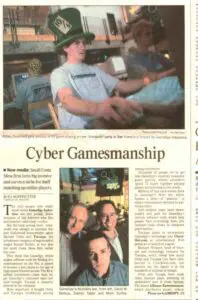Back when we were all trying to figure out the real value of traffic on the web, we investors – and acquiring companies – got a bit crazy with metrics used to value acquisitions and investments. Since in most cases, there was no revenue in many of these companies, all trying to gain market share at any cost, we had to invent the metric to use. And the most logical one seemed to be “eyeballs” or number of unique users finding their way to the site or registering for the service.
And the numbers were staggering. Microsoft paid $9.00 per registered user for Hotmail. AOL paid $40.00 per registered user of ICQ, the early messaging service. I was the original investor and helped to grow GameSpy Industries, attracted to the fledgling company because of its million users  each month, even though at the time there was no monetization to the traffic.
each month, even though at the time there was no monetization to the traffic.
But, when the bubble burst in 2000, most of us quickly grew up. Revenue models became more important a measure than traffic, although market share was and still is an over-weighted part of the value of any Internet-based entity.
[Email readers, continue here…] That is the quandary which entrepreneurs face today in building models for new companies around a web presence. Great revenue projections from a small user base lead to worries over sustainability. Low revenue projections but demonstrated (or projected) impressive numbers of unique users lead investors to think that there may be a future method of monetizing the user base that makes the company attractive, even while currently losing money.
I am an investor and advisor to one such company. Gaining users at a rate of 50% a month, the company has yet to find a revenue model that will pay for the increased costs of infrastructure needed to support the growth, let alone the fixed cost of operating the enterprise. And yet, users rave about the service, and spend long durations of time on the site.
Once we had what we thought was the answer, in allowing for display advertising on these sites. But the competition among sites has overwhelmed available inventory of paying advertisers, greatly reducing the cost per thousand views, and making display ads no longer a preferred revenue source for marginal sites.
We experimented with subscription-based charges for game sites and other sites supplying what we thought were indispensable services. In every case, those subscription models failed, as users found free alternatives. One of my companies had four million free beta gamers registered on the site, but lost all but 10,000 when attempting to charge $9.95 a month for a subscription.
What is the answer? New forms of advertising have been created to force user views, including pop-ups, pre-roll ads containing video content, and click-through display ads before allowing content views. Major newspapers and magazines, trying to reinvent themselves, are using the subscription model, as well as all of the above methods in their attempt to become relevant to a new and growing mobile and Internet-focused user base, with varying – but not too satisfying results.
well as all of the above methods in their attempt to become relevant to a new and growing mobile and Internet-focused user base, with varying – but not too satisfying results.
Micropayments, in which services and information are delivered for pennies, requires an infrastructure for collecting, accumulating and billing that is still being experimented with, but showing promising results.
Giants like Facebook and Google have such large eyeball numbers that they can use display and positioning ads to achieve great profits. Most of us are still searching for the combination of monetization devices that work best for us. Free sites without monetization will disappear over time, and we will lose services we take for granted today. It is in the best interest of both Internet users and providers to find an acceptable way to charge for valuable services or information.









I also say that Dave’s right. It’s really hard to attract actual paying customers. So much is available free nowadays that it’s hard to make a value proposition.
My strategy — to be proven out this year — is to always have a “hook” that can justify asking people to pay for your product. For example, we are developing a game that encourages children to play cooperatively. It works for all kids, but is especially designed to assist those with Autism Spectrum Disorder (ASD) in recognizing the value of positive social interaction. But that’s not a hook. The hook is that we have a formal clinical study from UC Irvine which we hope will establish that it actually does work. That’s something we can promote.
In another case, we are developing two social games with a special mode that’s uniquely appealing to a certain demographic. A business partner is developing a suite of games with this feature, and will market all of them as a “destination” site for this particular mode of play. They need product; we need users. Mutually beneficial arrangement that should help gain those precious eyeballs and turn them into actual paying players.
I think all we have to do is take a look at our own devices and subscription habits to tell us what we pay for and what we do not.
On my 6 month old Nexus I have 38 apps downloaded and a number I deleted quickly after realizing they added nothing. Of those 38 active apps 1 has received significant revenue from me – Amazon. The rest nothing. Though I have been experimenting with paid advertizing on Facebook on another device and it has yielded 0 results in terms of new customers. FB’s new monetization to gain “likes” tries to make you feel good while you pay them money – they do a decent job of “that” but I suspect if anyone can ever actually measure the real results they will start wondering if it is a total waste. I believe FB will flounder once real metrics can be pulled out of the NSA data bank :-))
37 developers/vendors THINK I am a potential customer. Maybe 5 of these work on the model that if they give me a little for free I will (when I go over their initial limit e.g. dropbox and such) pay the extra to extend the service. They may be right but so far they have not been.
Of the rest I have not clicked on nor even noticed their tiny little ad blocks. The vendors who insist I sit through a 20 to 30 second ad are always consigned to the digital coffin.
How many apps are there in the Google Play store? How many lines of code have been chomped out in the name of the great god “potential”.
Dave’s gloom is right on, Berni
This is a depressing analysis. You’re saying that we have no real answers to the most serious problem any of us has with delivering services online.
I have been wrestling with this problem for well over ten years. I am frustrated by seeing inferior services take business away because they are (a) free or (b) marketed more aggressively.
I began by offering a year of service for free because we had zero customers at the time. Ever since we have been in revenue, we have not offered our services for free but have provided a taste for prospects. Today, we even have a link on our home page that allows anyone to try us out to see if we’re compatible with their infrastructure. (We run in HTML5 these days and are compatible with any modern platform.)
If you charge, you must be willing to spend 25-50% on sales and marketing. It’s a tough market out there, especially in education, which is our market. Secondly, you must decide on retail or wholesale. We chose the latter because we just weren’t interested in building a large sales organization. That would distract from our core strengths. Others work the other way around and so become potential partners for us — a nice synergy when it works.
Every potential customer for every online service is overwhelmed by the options and number of companies asking for their business. You must find a way to stand out, to get past the market noise and get in front of the decision maker.
I wish I had a better solution, but I am stuck with the old-fashioned grunt work of finding distribution channels even in this amazing era of technology. I spend time every day looking at news that may impact me and introduce me to a new partner. That is how I managed to get to California State University with whom I know have a contract.
Wouldn’t it be nice is you could just FaceBook or Twitter your way to success. If it were easy, everyone would be doing it, and you’d be buried in the landslide. We have the best product by far in our space and continue to work hard for every sale.
Dave, A very informative and eye opening post.
You have answered some important questions that have been on my mind.
Thank you!